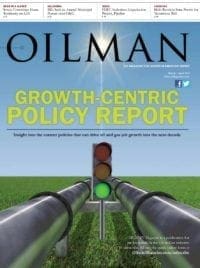Janet McCabe, Acting Assistant Administrator for the U.S. Environmental Protection Agency (EPA) Office of Air and Radiation on Jan. 14 released the details of a new goal to cut methane emissions from the oil and gas sector by 40% to 45% from 2012 levels by 2025, and a set of actions to achieve that goal.
Methane emissions accounted for nearly 10% of U.S. greenhouse gas emissions in 2012, of which nearly 30% came from the production, transmission and distribution of oil and natural gas, according to an EPA statement. Emissions from the oil and gas sector are projected to rise more than 25% by 2025 without additional steps to lower them, the EPA said.
The plan includes a coordinated, cross-agency effort that considers the role of the Federal Energy Regulatory Commission (FERC), state utility commissions and environmental agencies, and industry.
The plan action items are:
- Propose and Set Standards for Methane and Ozone-Forming Emissions from New and Modified Sources – The EPA will initiate a rulemaking effort to set standards for methane and volatile organic compounds emissions from new and modified oil and gas production sources, and natural gas processing and transmission sources. EPA will issue a proposed rule in the summer of 2015 and a final rule will follow in 2016. In developing these standards, EPA will work with industry, states, tribes, and other stakeholders to consider a range of approaches that can reduce emissions from the sources such as oil well completions, pneumatic pumps, and leaks from well sites, gathering and boosting stations, and compressor stations.
- New Guidelines to Reduce Volatile Organic Compounds – The EPA will develop new guidelines to assist states in reducing ozone-forming pollutants from existing oil and gas systems in areas that do not meet the ozone health standard and in states in the Ozone Transport Region. These guidelines will also reduce methane emissions in these areas. The guidelines will help states that are developing clean air ozone plans by providing a ready-to-adopt control measure that they can include in those plans.
- Consider Enhancing Leak Detection and Emissions Reporting – The EPA will strengthen its Greenhouse Gas Reporting Program to require reporting in all segments of the industry. In addition to finalizing the updates to the program EPA has already proposed by the end of 2015, EPA will explore potential regulatory opportunities for applying remote sensing technologies and other innovations in measurement and monitoring technology to further improve the identification and quantification of emissions and improve the overall accuracy and transparency of reported data cost-effectively.
- Update Public Lands Standards – The Department of Interior’s Bureau of Land Management (BLM) will update decades-old standards to reduce venting, flaring, and leaks of natural gas, which is primarily methane, from oil and gas wells. These standards, to be proposed in the spring, will address both new and existing oil and gas wells on public lands. BLM will work with the EPA to ensure an integrated approach.
- Create Pipeline Safety Standards – The Department of Transportation’s (DOT) Pipeline and Hazardous Materials Safety Administration will propose natural gas pipeline safety standards in 2015.
- Drive Technology to Reduce Natural Gas Losses – President Obama’s FY16 budget includes $15 million in funding for the Department of Energy (DOE) to develop and demonstrate more cost-effective technologies to detect and reduce losses from natural gas transmission and distribution systems. This action will include efforts to repair leaks and develop next generation compressors. The budget also proposes $10 million to launch a program at DOE to enhance the quantification of emissions from natural gas infrastructure for inclusion in the national Greenhouse Gas Inventory in coordination with EPA.
- Modernize Natural Gas Transmission and Distribution Infrastructure –The DOE will:
- Issue energy efficiency standards for natural gas and air compressors
- Advance research and development to bring down the cost of detecting leaks
- Work with FERC to modernize natural gas infrastructure
- Partner with the National Association of Regulatory Commissioners and local distribution companies to accelerate pipeline repair and replacement at the local level
- Quadrennial Energy Review (QER) – The Obama Administration will release the first installment of the QER, which focuses specifically on policy actions that are needed to help modernize energy transmission, storage, and distribution infrastructure. This installment of the QER will include additional policy recommendations and analysis on the environmental, safety, and economic benefits of investments that reduce natural gas system leakage.
Industry Action
Several voluntary industry efforts to address existing sources of methane emissions are underway, including the EPA’s plans to expand on the Natural Gas STAR Program by launching a new partnership in collaboration with key stakeholders later in 2015. The EPA will work with DOE, DOT, and certain companies, individually and through broader initiatives such as the One Future Initiative and the Downstream Initiative, to develop and verify commitments to reduce methane emissions.
Disruptive Regulations
In a Jan. 14 statement about the EPA’s proposed new regulations, American Petroleum Institute President Jack Gerard said that methane emissions from oil and natural gas production are falling, and new regulations on methane disrupt America’s energy renaissance.
“As oil and natural gas production has risen dramatically, methane emissions have fallen thanks to industry leadership and investment in new technologies,” Gerard said. “And even with that knowledge, the White House has singled out oil and natural gas for regulation, where methane emissions represent only 2% of total greenhouse gas emissions.”
Gerard said that existing EPA and state regulations are already working, and more regulation will be burdensome.
“We need our government to implement sound policies, but this plan seems to be based on politics,” Gerard said. “We hope EPA will work with industry during the regulatory process to ensure that any regulations are based on science and technology and do not impair the industry’s ability to supply America with energy.”-JD




